Steering Cummins down a path to zero
15 March 2022
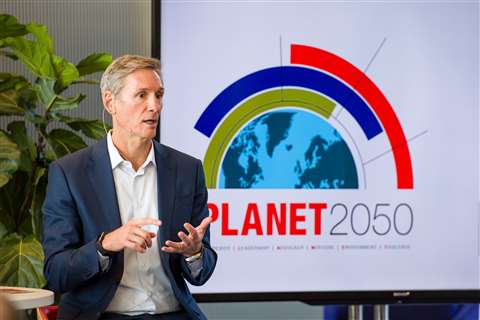 Cummins CEO Tom Linebarger at the launch of the company’s PLANET 2050 initiative, a program that aims to significantly reduce greenhouse gas emissions from the company’s facilities and products, generate less waste and reduce water consumption over the next 30 years. (Photo: Cummins)
Cummins CEO Tom Linebarger at the launch of the company’s PLANET 2050 initiative, a program that aims to significantly reduce greenhouse gas emissions from the company’s facilities and products, generate less waste and reduce water consumption over the next 30 years. (Photo: Cummins)
While it can arguably lay claim to being the world’s preeminent diesel engine supplier, Cummins Inc. has also been among the pioneers in the development of technologies such as electric powertrains, gaseous fueled combustion engines and all things hydrogen – combustion engines, fuel cells and even infrastructure for manufacturing hydrogen.
The company first announced the establishment of a business dedicated to electrification technology and applications in 2017 and two years later, expanded and rebranded the business as Cummins New Power, encompassing electrification and the range of alternative power technologies.
Cummins Chairman and CEO Tom Linebarger recently discussed the company’s goals and ambitions related to decarbonization and New Power technologies.
Late last year Cummins announced its PLANET 2050 goals and has accelerated its decarbonization efforts. Why did you feel it was important to go ‘all-in’ like that now?
There are a couple of reasons. I think first of all, just from a general citizenship point of view, there’s no question that, that climate change is the existential threat of our time and we owe it to our kids or grandkids to do something before it’s too late. I just don’t understand how I could explain to my daughters that I didn’t do whatever I could do, to head off the biggest disaster in the history of the human race. I don’t mean to sound overly dramatic, but it is that dramatic – the warming of the planet changes everything.
I think all of us, as just as citizens and certainly as a leader of a company with skills and resources, have to figure out what we’re doing to address the problem and not leave it to our kids and grandkids. So that’s one.
 “I just don’t understand how I could explain to my daughters that I didn’t do whatever I could do, to head off the biggest disaster in the history of the human race.” - Tom Linebarger, Cummins CEO
“I just don’t understand how I could explain to my daughters that I didn’t do whatever I could do, to head off the biggest disaster in the history of the human race.” - Tom Linebarger, Cummins CEO
The second is Cummins has been tied into this idea since its founding. We’re founded on innovation on solving the most important problems of industry and environment. During the Clean Air Act period when new emission standards were put in place that were actually quite challenging for the industry, that’s where Cummins really hit its stride. Our people put their innovative capabilities to work, we pulled together as a team, we found new solutions to trucking and construction problems, the most difficult power problems on the planet, and did it in a much cleaner way.
And so now that we have the same challenge to do on carbon, our people are excited about it. They’re not thinking this is something they wish they didn’t have to do. In fact, this is just the latest in a series of innovation challenges that our company has taken on and what I find when I go around the company and talk to our people is this is what they’re made to do.
That’s why we put both feet in and it was really just a question of developing a strategy to put our people to work that we’ve been working on for the last 10 years or so.
At the Diesel Progress Summit, (Cummins Vice Chairman) Tony Satterthwaite said that when EPA started its emissions reduction program, Cummins wasn’t sure it could get there. Is there any of that same sentiment as you look at the various New Power technologies?
No question about it. When we set the 2050 targets saying that we will be net zero carbon, we set that for our products which of course are the biggest impact on climate, but also for our facilities, for our supply chain, also on waste and on water usage. They’re very aggressive targets and the fact is that we don’t have the technologies to meet those targets today, at least not in an affordable way.
There’s a lot of innovation and development left to go to hit those targets. But we are confident, as Tony said, that we will find a way. We do understand what the pathways are but there’s a lot of development left to go, and cost is a big one.
We’ve got to figure out a way to get some of the lower carbon technologies down in cost which of course ties to volume – the more volume we can put out there, the lower the cost can be. There’s innovation and development to get to get done, plus infrastructure.
You can’t overemphasize the importance of infrastructure in our industries. All of our products that we sell rely on infrastructure, everything from roads to fueling stations to electricity and making sure that infrastructure also is zero carbon will be as important as the technologies that go in the vehicles or go in the pieces of equipment to meeting the zero carbon targets.
Cummins recently unveiled a new heavy-duty natural gas engine and is supplying some electric powertrains to vehicle manufacturers such as Gillig. How important is it to help customers start down that decarbonization path now rather than wait until more zero-carbon options are available?
Getting people started now is one of the linchpins of our strategy. We’ve labeled our strategy Path to Zero and the reason we use those words is because we have to make sure the path leads to zero carbon emissions by 2050. That’s a given – everyone understands that.
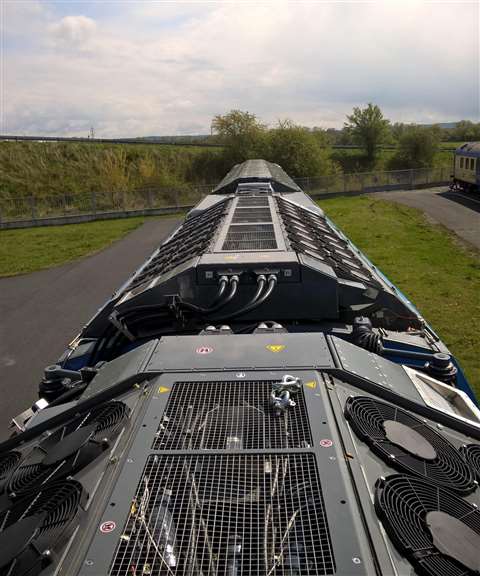 As an example of Cummin’s New Power efforts, Cummins expects to have 40 fuel cell trains, running on renewable hydrogen, operating in Europe by the end of 2022. (Photo: Cummins)
As an example of Cummin’s New Power efforts, Cummins expects to have 40 fuel cell trains, running on renewable hydrogen, operating in Europe by the end of 2022. (Photo: Cummins)
We also know that the path has to start now because carbon emissions are a little bit like compound interest – the more you put out today, the more decarbonization you have to do in the future, because it sits up there and accumulates and causes challenges today. If we can make impacts today, we’ll have less of a problem in the future.
What we want to do not only is get to zero, but we want to get down the path quickly so we want to utilize existing technologies. Internal combustion engines are very well developed – 100 years plus from Cummins alone of internal combustion engines – they’re very affordable, very reliable, very durable, they work in a wide range of applications. We want to put those to work right now.
And things like natural gas and then renewable fuels, move us down the carbon path towards zero. They don’t get you all the way there, but they move a long way. That fuel economy, and natural gas can move us to almost 25% lower carbon based on the technologies we see with existing engine technology.
And then you start to do hybridization, then you start to do BEVs, you start to do fuel cells and what you end up with is a path that brings every customer no matter how hard to abate their sector is, down the curve. You’re making impacts today on carbon, significant ones not tiny ones, 25% now, and then all the way to zero.
In the interim, the infrastructure I talked about catches up. Because if you put electricity in battery electric vehicles today and that electricity is largely made up of coal, you actually haven’t improved carbon – either at all or very much. So what we want to do is move fast on the things we can move fast on and keep pushing on the technologies to make them more available cheaper, and then also have the infrastructure in place.
That’s the path that we’ve laid out and you will see us release an entire new range of engines across the board that will be able to take fuels of various types – natural gases, you mentioned renewable fuels and hydrogen fuels – to help customers move down this path towards zero.
Is it fair to say that we’ll be seeing cleaner combustion engines for quite some time to come?
For sure. What’s more, my expectation is it’ll depend by sector, sector and region.
In some sectors – you mentioned, Gillig buses – in the municipal bus space, the school bus space, we’re seeing electrification happen pretty quickly. The mission of those vehicles lends itself to electrification … stop-and-go, relatively modest distances, relatively modest loads compared to some of the other applications. A battery electric or a hybrid or a fuel cell electric work pretty well in those applications so we’ll see those move pretty quickly.
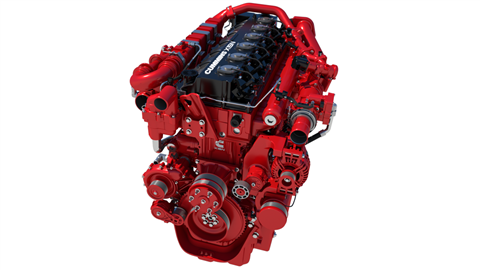 Linebarger said that engines such as the ISXN natural gas engine unveiled in late 2021, are critical in beginning the move toward zero emissions in the near term. (Photo: Cummins)
Linebarger said that engines such as the ISXN natural gas engine unveiled in late 2021, are critical in beginning the move toward zero emissions in the near term. (Photo: Cummins)
There’ll be ones in the middle that’ll move, but they’ll take a little bit longer. Those that are much harder to abate, where an internal combustion engine with a natural gas fuel or a renewable fuel and maybe even eventually, a hydrogen fuel, will move us way down the carbon path with a technology that’s already existing and easier to deploy.
When a lot of people think of hydrogen, they think fuel cells. Where is Cummins in terms of commercialization of fuel cells for on- and off-road applications?
We’ve made a pretty large investment in hydrogen technologies. The reason that we’ve done that, along with our battery electric technology, is because we serve a range of applications where power density is really critical, very large power first of all, and that weight-to-power is a really important ratio.
Batteries, we will see how they evolve, but batteries today don’t look like the perfect solution for some of those applications. Whereas hydrogen represents a fuel which has good power density still and can be made, if we use electrolysis and renewable electricity, we can make it carbon-free.
So we have invested both in electrolysis, the technologies that can convert renewable energy to hydrogen, and then fuel cells, which can use that renewable hydrogen to power really high load, big range applications.
Already we expect to have 40 trains running in Europe by the end of (2022) and those trains will all be powered by fuel cells with renewable hydrogen. If you think about that application, that’s a very high-powered application, density matters a lot there, so fuel cell is a good solution for that technology. The same situation in long haul highway trucks, where you need to haul enough fuel to be able to go long distances and carry high loads.
We are significantly far along in the development of that technology as you can tell by the fact that we’re already deploying it with passengers in production. What we’re trying to do now is build scale in the technology so that we can bring the cost down and move it into transportation and other places. Also, we’re trying to build up the availability of affordable green hydrogen because there is no point to have a fuel cell vehicle if you can’t buy hydrogen to fuel it.
So both the development of electrolysis, and production of hydrogen along with fuel cell technology is necessary for it to play a major role in trucking, for example, or many other applications
With the work on hydrogen production, Cummins seems to be trying to supply both the chicken and the egg to customers.
That’s because the infrastructure isn’t there. Normally, we would just provide the power for people to use. But in this case, if we just sold fuel cells, no one would buy them because there’s no way to fuel. So we need to get into it.
You may remember when we first started introducing aftertreatment systems, we were also in the DEF business and part of that was to make sure that customers could actually use our solutions and had available DEF to put in the systems and make them function well. And once that was done, then we let the industry take it and run.
We’ll see what happens on the hydrogen side. Our view is we’re early in early enough and there are enough applications that we see it as a strategic growth area. But we actually got in it initially just to enable the industry. Now of course it’s it looks like a lot of growth for Cummins, so we’re pretty committed to building out our electrolysis business.
One issue with decarbonization is that regulations are a patchwork of dates, regions, etc. Is Cummins encouraging regulators to develop a more organized process similar to diesel emissions programs?
The answer is a hearty yes. I just came back from Washington DC, talking to members of the U.S. government about both the importance of climate change, industry’s readiness to put out technologies that will help us reduce carbon and the importance of a regulatory framework to encourage investment and to make investments move faster.
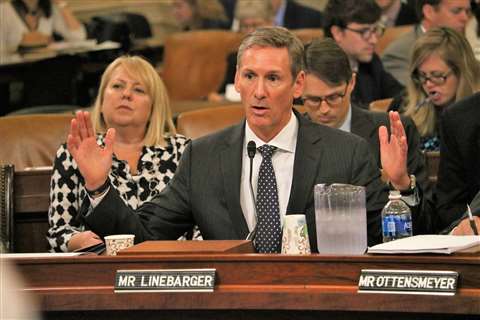 Linebarger has testified to Congress about “the importance of climate change, industry’s readiness to put out technologies that will help us reduce carbon and the importance of a regulatory framework to encourage investment and to make investments move faster.” (Photo: Cummins)
Linebarger has testified to Congress about “the importance of climate change, industry’s readiness to put out technologies that will help us reduce carbon and the importance of a regulatory framework to encourage investment and to make investments move faster.” (Photo: Cummins)
My biggest fear is that everybody feels that it’s important, but we spend a lot of time mustering – we just get ready to get ready to get ready to do something. And as you said, a patchwork of regulations makes it complicated for industry participants to make investments that they can see a return on and that especially can drive volume, which brings down cost which encourages volume. Then you get that virtuous circle of cost and demand that that leads to replacement of one technology over another.
The advantage of incumbent technology is significant infrastructure and the cost is good. So if we really want to do a replacement of the grid with renewable power, if we want to put in a hydrogen infrastructure, if we want to see all the trucks and cars change over, that’s a massive investment that’s going to take the scale of the entire U.S. industry to get to – which means that the basic regulatory and economic system needs to support those investments at scale.
I do think governments, the EU government, U.S. government, Chinese government, I think they understand that. I just think it’s trying to manage through the political and civil concerns they’ve got about environmental justice and how to get the laws set up to do it.
But I would just tell you, my overwhelming belief is without a price on carbon, the industry will not move fast enough. I do think there are other very important regulatory structures to sort out – there are infrastructure investments by the government, there’s technology investments and incentives provided by the government. But most of all, the single most important stroke they could do is to put a price on carbon.
I was at COP 26 and to see the number of companies that were there and how strongly they’re leaning into technologies that will reduce carbon, it was overwhelming. Even more impressive to me than all the government negotiations was how many companies were there ready to move. If they could just get the right signals that if we move now, it will actually pay back.
And I don’t mean pay back quickly. Most of us are prepared for decade-long returns. The question is, will the infrastructure and regulatory environment even support it then? And so what I’ve been encouraging governments everywhere I visit is that a price on carbon tells everybody it’s serious, we will be supporting low-carbon technologies for the long haul.
It can start low, but it needs to be in place in the in the end, the structure needs to be in place to encourage people every sector of the economy to invest in technologies that are lower carbon,
When you say a price on carbon, are you saying a carbon tax or a carbon incentive program?
I’ve been informed not to use the word ‘tax’ in any circumstances by my friends in government. I have a personal preference, because I did a lot of economics in college, that I think a carbon tax or carbon fee is the simplest and most straightforward economic way to do it. But the fact is that’s not my job, that’s others. I just want to encourage people to have a price of some kind.
There’s cap-and-trade systems, there’s carbon fees and carbon tax systems. There are other ways to get at it. But what I’m really trying to do economically, is take an externality – if we put carbon in the atmosphere today, it’s essentially free, none of us have to pay anything for that – and therefore, we don’t really feel direct pain. We continue to do it as consumers as producers as everybody else. And if you restrict your carbon emissions, you will feel good about that, but you’ll pay more money for things to do it and you’ll get no direct benefit because if other people pollute, then it doesn’t change anything.
So the answer is to change that equation. Say to people, ‘everyone who puts out carbon has to compensate the rest of the society for it.’ And then all that happens is people consume less carbon and produce less carbon.
That’s where we need to get to and there’s a bunch of ways to do it. My own view is carbon tax or carbon fee is the simplest and most economically efficient. But you know, I’m an engine leader, not a policy person.
One real challenge to decarbonization is that it’s hard to make money at it and that could be the case for some time. How does Cummins deal with that reality?
We are primarily targeting our R&D and development efforts first at the sectors where it looks like more demand will come sooner. I mentioned trains with fuel cells, I mentioned buses with electric powertrains and the reason is that those are subsidized sectors, the applications lend themselves to the technology so that the repayment happens quicker. Even though on their own, they may not be viable, there are enough subsidies to help and they’re more viable than say, a trucking application.
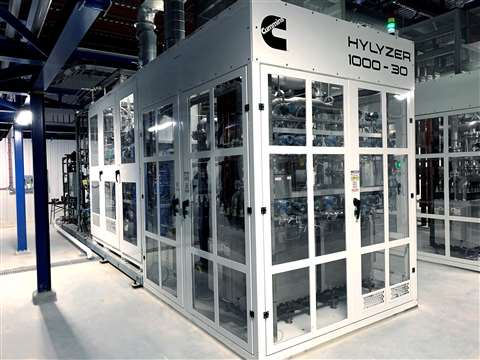 In an effort to provide the needed infrastructure for hydrogen products, Cummins has expanded its New Power business to include electrolyzers that create hydrogen that can be used for combustion engines and fuel cells. (Photo: Cummins)
In an effort to provide the needed infrastructure for hydrogen products, Cummins has expanded its New Power business to include electrolyzers that create hydrogen that can be used for combustion engines and fuel cells. (Photo: Cummins)
So where we’re aiming our effort is put things out in the sectors that are most receptive to these technologies first. That gets us from out of the lab and into the real world, learning about how to make the products more reliable, more durable, easier to use, and basically better for customers. These customers have to be up all the time so no thanks to prototypes and stuff like that. Those are fine for demonstrations or for a show, but I can’t run those. We need to get our technologies from that lab prototype to real products that people can use.
The second thing we’re doing is looking for signals as to where regulation or infrastructure looks like it’s going to be there. We are seeing increasing efforts for example in California to build hydrogen corridors. If we start to see hydrogen corridors come on board in California, we can aim our fuel cell technology and development for trucks towards that as a way to say to customers, hey we could maybe make this work.
You may have seen we recently agreed to set up a plant to build electrolyzers in Spain. The reason we did that is we saw conditions in Spain, which include very affordable renewable energy, very good solar energy costs and European programs that wanted to help fertilizer companies convert to lower carbon solutions, so that’s why we set up there.
Think of it as basically trying to move our developments forward by finding the sectors and the locations where things are more attractive first, knowing that over time, things will get better and better. And then the entire industry will move across at some point.
Are you happy with the progress of your New Power business?
Never happy. I’ve learned over the years that impatience – as long as I don’t get over the top – is a virtue. Always thinking to yourself, how could we go faster, what could we do to push harder is an important thing when you’re doing strategic change.
There is always a tendency to want to fall back to what we know, to what we have developed before what we understand the most and I think that’s a that’s a trap.
Our company needs to continue to produce existing technologies to help people come down the Path to Zero. That’s going to take a while for a lot of industries. There’s going to be a long period of transition and we’re going to support those transitions. And we also need to move as quickly as we can go down this decarbonization path.
Again, I just don’t know what I would say to my kids if I didn’t push as hard as I know how towards finding technologies that can decarbonize our industry and give everything I have to make them more affordable and more available.
To hear a full audio version of this interview, go to https://www.dieselprogress.com/news/podcast-cummins-ceo-talks-path-to-zero/8017608.article
STAY CONNECTED




Receive the information you need when you need it through our world-leading magazines, newsletters and daily briefings.
POWER SOURCING GUIDE
The trusted reference and buyer’s guide for 83 years
The original “desktop search engine,” guiding nearly 10,000 users in more than 90 countries it is the primary reference for specifications and details on all the components that go into engine systems.
Visit Now
CONNECT WITH THE TEAM









